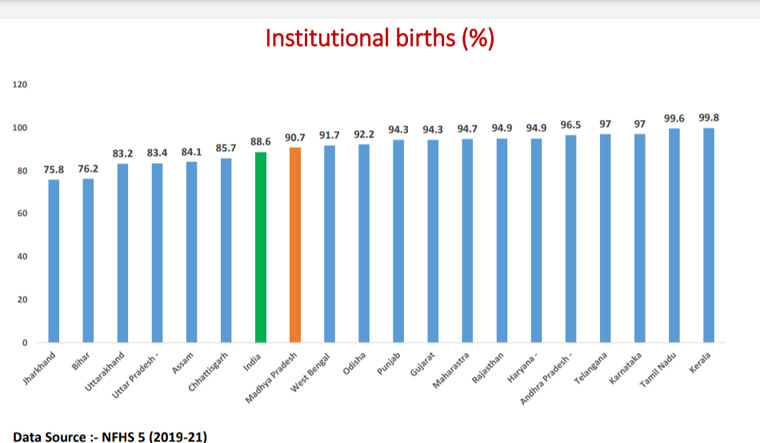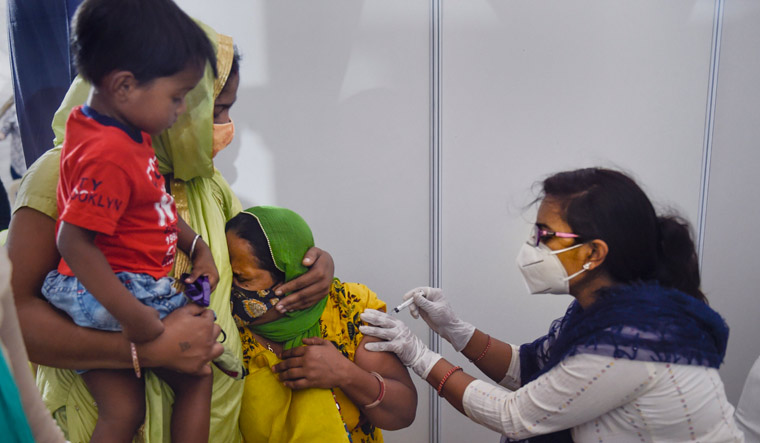Nutritional and health status of children and women in Madhya Pradesh—for a long time considered one of the worst performing states—have shown significant improvement, according to the data of the fifth edition of National Family Health Survey (NFHS-5) 2019-2021. The data was released on Wednesday by the ministry of health and family welfare.
Stunting, which shows chronic malnutrition among kids, has shown a dip of 6.3 per cent during the past five years (compared to NFHS-4, 2015-16) while wasting, which signifies acute malnourishment, has gone down by 6.8 per cent in the duration.
Yet about one-third of kids in the state (35.7 per cent) are stunted and almost one in five (19.0 per cent) are wasted, the latest report shows.
The percentage of underweight children—signifying short-term nutrition deficiency—has shown the most significant dip at 9.8 per cent, compared to NFHS-4. Now, the percentage of underweight kids in the state stands at 33.0 per cent, almost half of 60 per cent reported in NFHS-3 of 2005-06.
Experts attribute sharp dip in underweight children to short-term measures including supplementary food programmes.

This is the first time that the nutritional status of kids in MP has come quite close to the national average. The national average of stunted kids is 35.5 per cent (dip of 2.9 pc compared to NFHS-4), that of wasted kids is 19.3 (dip of 1.7 per cent) while that of underweight kids is 32.1 per cent (dip of 3.7 per cent). This shows that the improvement in Madhya Pradesh is far better than the national average.
NMR, IMR, U5MR go down sharp
Significant dips have also been registered in mortality indices of kids with neonatal mortality (death of newborn babies under age of one month) coming down to 29.0 per 1000 live births (PTLB) from 36.9 PTLB in NFHS-4. The infant mortality rate (death of babies under one year of age) has dipped to 41.3 PTLB from 51.2 PTLB, while the under five mortality rate (death of kids below five years of age) has dipped to 49.2 PTLB from 64.6 PTLB.
Improvement in mortality indices signifies betterment of ante-natal care for women and institutional health facilities related to child birth apart from general betterment in nutritional status of women and kids.
This is reflected in the fact that the institutional child births (at government or private hospitals) has gone up to 90.7 per cent compared to 80.8 per cent in NFHS-4, breastfeeding within an hour of birth has gone up to 41.3 per cent from 34.4 per cent, though yet more than half children are not breastfed within the hour of birth and are deprived of the nutritious first milk of mother.
Exclusive breastfeeding up to the age of six months has however gone up to 74.0 per cent from 58.2 per cent, which is a good rise. Despite the rise however, only as few as 7.7 per cent children in the age group of 6-23 months get adequate diet, the survey report shows. In NFHS-4, this percentage was even lower at 4.9.
Other improvements have come about in lowering of underage marriages both in women and men. Women marrying before 18 went down to 23.1 per cent from 32.4 per cent, while men marrying before 21 went down to 30.1 per cent from 31.2 per cent. Use of menstrual hygiene measures almost doubled in the state at 60.5 per cent from 37.6 per cent in NFHS-4.
Rise in anaemia cause of concern
Despite overall improvement, one cause of concern has emerged in the form of an increase in the number of anaemic kids, women and adolescent girls. Anaemia impairs metabolism, temperature regulation, immune function and work performance. Anaemia during pregnancy can increase the risk of premature births and lead to infant mortality, experts say.
The NFHS-5 shows that the number of anaemic children in the 6-59 month age group has gone up to 72.7 per cent from 68.9 per cent in NFHS-4, while the number of anaemic women in the 15-49 age group rose to 54.7 per cent from 52.5 per cent. Similarly the percentage of anaemic adolescent girls (15-19 age group) has gone up to 58.1 per cent from earlier 53.2 per cent. However, the number of anaemic pregnant women has shown slight decrease to 52.9 per cent from 54.6 per cent, the data shows.
The data also shows that though women's participation in household decisions like health care for self, major household purchases and visits to family/relatives has improved to 86.0 per cent from 82.8 per cent, the women who worked during 12 months prior to survey and were paid cash for it, went down to 26.8 per cent from 29.9 per cent in NFHS-4.
When contacted, state secretary and commissioner of health, Akash Tripathi said that Madhya Pradesh has shown significant improvement and shared a document prepared by the health department comparing MP to other states and national average on various indices of NFHS-5. He however did not comment on the question of high anaemia and the reasons for achieving improvement.





